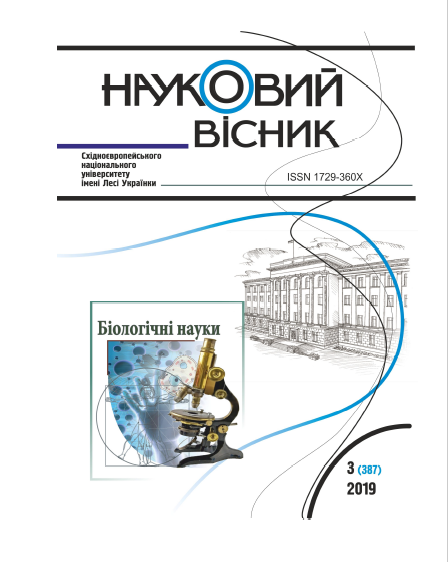Analysis of Ontogenic Structure of Thymus Serpyllum L. Emend. Mill. and Thymus x Polessicus Klokov (Lamiaceae) Coenopopulations Under the Conditions of the Ympil District, Sumy Region (Ukraine)
DOI:
https://doi.org/10.29038/2617-4723-2019-387-38-44Keywords:
ontogenic structure, cenopopulation, Thymus serpyllum, Thymus polessicusAbstract
The paper contains the characteristics of Thymus serpyllum and Thymus polessicus plants of various ontogenic stages and their percentage in five cenopopulations. Age index by A. A. Uranov and efficiency index by L.V. Zhyvotovskii are calculated, and each cenopopulation is assigned to a certain ontogenic category. On the ground of obtained results, conclusions are made regarding considering the ontogenic structure of Th. serpyllum and Th. polessicus cenopopulations in the conditions of Yampil district of Sumy region. Complex assessment of the ontogenic structure of populations was conducted using a specialized software and conventional methodologies. Showed that the majority of populations are represented by plants of 3–9 ontogenic stages. Most constant are the generative and old individuals present in all investigated cenopopulations. Based on the ratio of the age index and the efficiency index (values of Δ / ω), it was determined that majority cenopopulations was ageing. The value of the age index (by the method of I.M. Kovalenko [12]) is bigger than 1 in all investigated cenopopulations, suggesting the prevalence of degradation processes. According to the classification of T. O. Rabotnov, all investigated populations belong to the category of «normal». All main characteristics of Th. serpyllum and Th. polessicus populations indicate their potential for sustainable existence in the study region. However, their viability appears to be different, with the most evident imitations being faced by the populations under the pine forest canopy (populations are incomplete as to the presence of various ontogenetic states). In contrast the population growth in Elytrigioso (repenae)−thymosum (serpyllae) is community distinguished by the most complete ontogenic structure. As a result of radical changes in natural ecosystems, there is a decrease in the populations of many species, which prompts us to find directions and ways of regulating the mechanisms of development of natural phytocenoses. As a promising scientific direction, the application of the morphometric and vital analyzes of the investigated cenopopulations will allow to evaluate the morphological parameters and survival rates of the individuals of Th. serpyllum and Th. polessicus in the studied area.
References
2. Minarchenko, V. M. Resursoznavstvo. Likarski roslyny [Resource-learning. Medicinal plants]: Navchalno-metodychnyi posibnyk. Kyiv: Fitosotsiotsentr, 2004; s 71. (in Ukrainian)
3. Iakubenko, B. Ye. Heobotanika: metodychni aspekty doslidzhen [Geobotany: methodical aspects of research]. Navchalnyi posibnyk. Kyiv: Lira, 2017; s 316. (in Ukrainian)
4. Klokov, M. V. Rasoobrazovanye v rode tymianov− Thymus L. na terytoryy sovetskoho Soiuza [Disposition in the genus of thyme-Thymus L. on the territory of the Soviet Union]. Kyiv: Naukova dumka, 1973; s 187. (in Russian)
5. Hohyna, E. E. Yzmenchyvost y formoobrazovanye v rode Thymus L. [Аriability and morphogenesis in the genus Thymus L.]. Botanyka. Moskva: 1983; s 430. (in Russian)
6. Hlushchenko, L. A.; Minarchenko, V. M. Do pytannia resursnoho potentsialu deiakykh chebretsiv Ukrainy. Problemy likarskoho roslynnytstva [On the resource potential of some thyme in Ukraine. Problems of medicinal plant growing], Materialy naukovo-praktychnoi konferentsii, 3−5 lypenia 1996. Poltava, s 23−24. (in Ukrainian)
7. Hlushchenko, L. A.; Syvohlaz, L. M. Otsinka vykhidnoho materialu dlia stvorennia rodovykh kompleksiv Thymus ta Hypericum [Evaluation of the source material for the generation of generic complexes Thymus and Hypericum. Methodological bases of formation, management and use of collections of genetic resources of plants]. Metodolohichni osnovy formuvannia, vedennia ta vykorystannia kolektsii henetychnykh resursiv roslyn. Materialy dopovidi
mizhnarodnoho sympoziumu, 2−4 zhovtenia 1996. Kharkiv, s 170. (in Ukrainian)
8. Nachychko, V. O. Ohliad system rodu Thymus L. (Labiatae Juss.) [Review of the systems of the genus Thymus L. (Labiatae Juss.)]. Visnyk ONU. Seriia «Biolohiia»; 2013, 18, s 7–21. (in Ukrainian) https://doi.org/10.18524/2077-1746.2013.2(31).44597
9. Nachychko, V. O. Rid Thymus L. (Labiatae Juss.) u flori Ukrainskykh Karpat: systematyka i taksonomichni problemy [Genus Thymus L. (Labiatae Juss.) In the flora of the Ukrainian Carpathians: taxonomy and taxonomic problems]. Visnyk Lvivskoho universytetu. Seriia «Biolohiia»; 2014, 64, s 159–169. (in Russian) https://doi.org/10.18524/2077-1746.2013.2(31).44597
10. Kazakova. M. V. Rod Thymus L.-−Timian. Chabrets. Flora sredney polosy Evropeyskoy chasti Rossii [The genus Thymus L. - Thyme, Thyme. Flora of the middle zone of the European part of Russia]. Moskva: 2006; s 440–442. (in Russian)
11. Gogina. E. E. O nekotorykh napravleniyakh evolyutsii zhiznennykh form v rode Thymus L. Zhiznennyye formy: struktura. spektry. Evolyutsiya [On some directions of the evolution of life forms in the genus Thymus L. Life forms: structure, spectra, evolution]. Moskva: 1981; s 46−76. (in Russian)
12. Smirnova. O. V. Obyem schetnoy edinitsy pri izuchenii tsenopopulyatsiy rasteniy razlichnykh biomorf. Tsenopopulyatsii rasteniy [The volume of the unit in the study of plant cenopopulations of various biomorphs]. Moskva: 1976; s 72–80. (in Russian)
13. Zhukova. L.A. Ontogeneticheskiy atlas lekarstvennykh rasteniy: nauchnoye izdaniye [Ontogenetic atlas of medicinal plants: scientific publication]. Yoshkar - Ola: MarGU. 1997; s 240. (in Russian)
14. Zhivotovskiy. L. A. Ontogeneticheskiye sostoyaniya. effektivnaya plotnost i klassifikatsiya populyatsiy rasteniy [Ontogenetic states, effective density and classification of plant populations]. Ekologiya. 2001; s 3–7. (in Russian)
15. Zlobin. Yu. A. Populyatsii redkikh vidov rasteniy: teoreticheskiye osnovy i metodika izucheniya [Populations of rare plant species: theoretical foundations and methods of study]. Universitetska kniga: Sumi. 2013; s 439. (in Russian)
16. Zlobin. Yu. A. Populyatsionnaya ekologiya rasteniy: sovremennoye sostoyaniye. tochki rosta [Population ecology of plants: current state, points of growth]. Universitetska kniga: Sumi. 2009; s 263. (in Russian)
17. Kovalenko, I. M. Struktura populiatsii dominantiv traviano-chaharnychkovoho yarusu v lisovykh fitotsenozakh Desniansko−Starohutskoho natsionalnoho pryrodnoho parku. Ontohenetychna struktura [The structure of the popular domain of the grass-chagarnish stage in the modern phytocenoses of the Desnyansko-Starogutsky National Natural Park. Ontogenetic structure]. Ukrainskyi Botanichnyi zhurnal; 2005, 62, s 707–714. (in Ukrainian)





